Deterioration: Traumatic Brain Injury and Nursing Interventions
VerifiedAdded on 2023/06/04
|8
|2465
|108
AI Summary
This report discusses traumatic brain injury and nursing interventions for patients with subdural hematoma and petechial hemorrhage. It covers nursing assessments, recommendations, and impacts of nursing interventions on the patient. The SMART tool is suggested for evaluating the success of interventions.
Contribute Materials
Your contribution can guide someone’s learning journey. Share your
documents today.
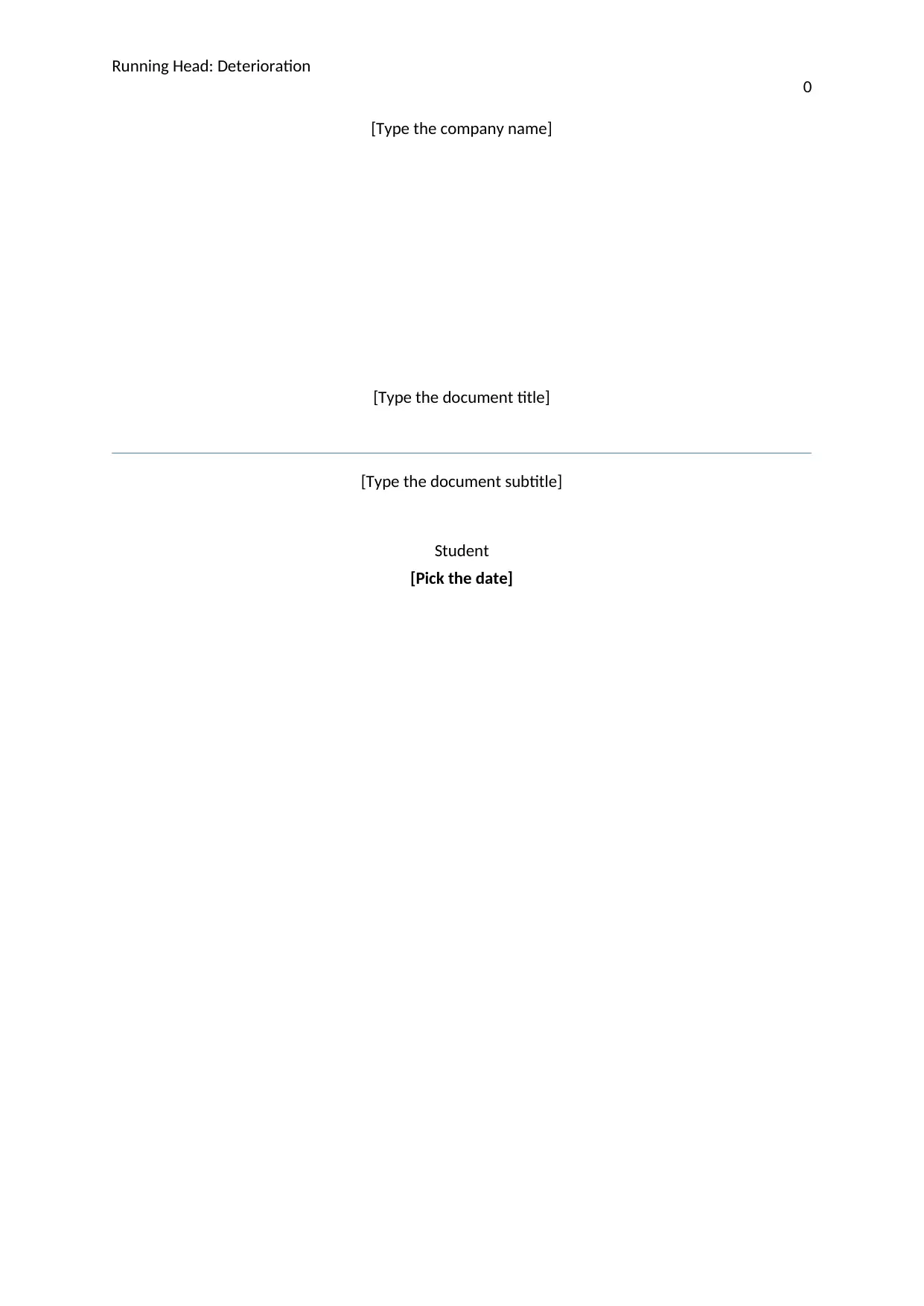
Running Head: Deterioration
0
[Type the company name]
[Type the document title]
[Type the document subtitle]
Student
[Pick the date]
0
[Type the company name]
[Type the document title]
[Type the document subtitle]
Student
[Pick the date]
Secure Best Marks with AI Grader
Need help grading? Try our AI Grader for instant feedback on your assignments.
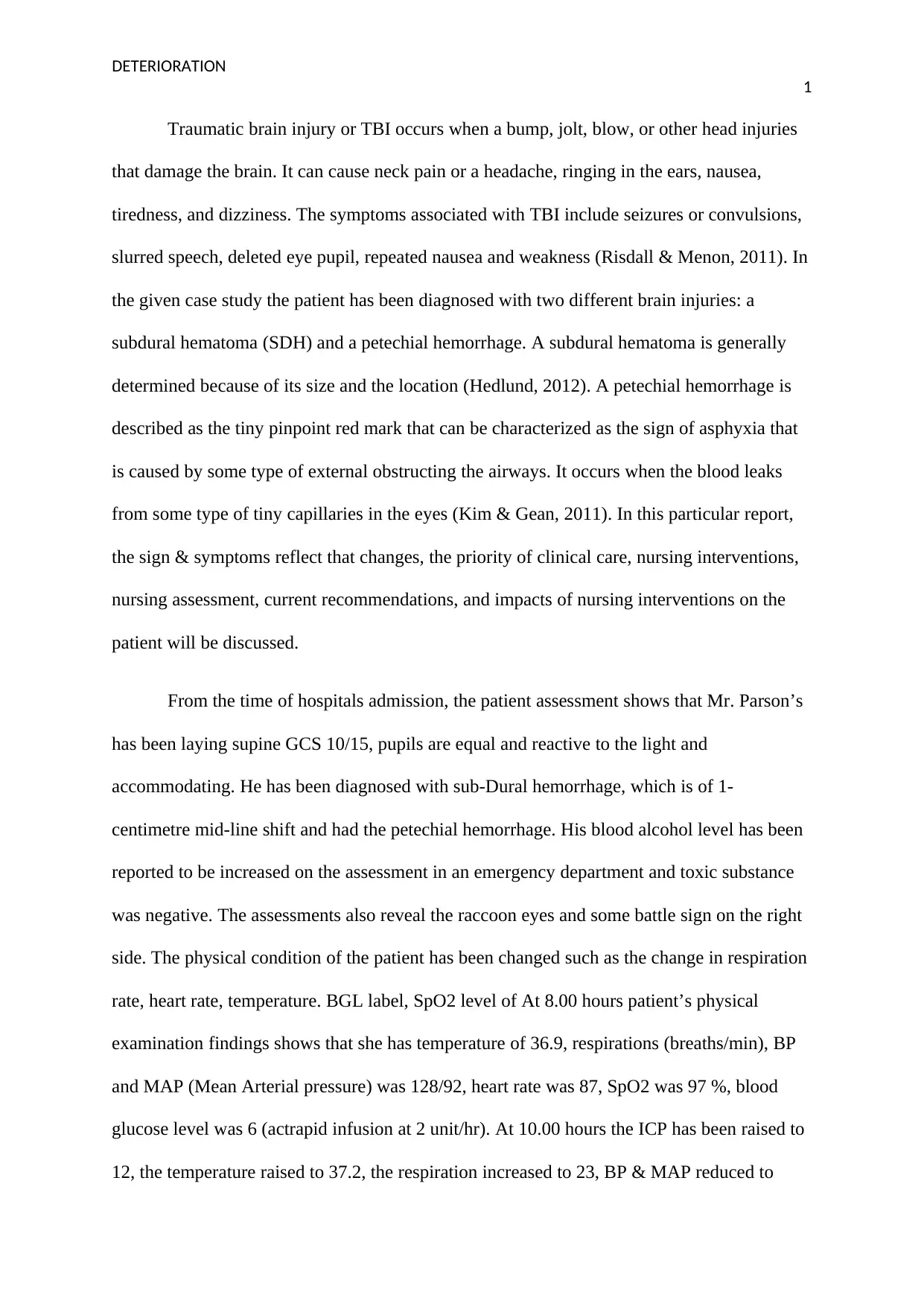
DETERIORATION
1
Traumatic brain injury or TBI occurs when a bump, jolt, blow, or other head injuries
that damage the brain. It can cause neck pain or a headache, ringing in the ears, nausea,
tiredness, and dizziness. The symptoms associated with TBI include seizures or convulsions,
slurred speech, deleted eye pupil, repeated nausea and weakness (Risdall & Menon, 2011). In
the given case study the patient has been diagnosed with two different brain injuries: a
subdural hematoma (SDH) and a petechial hemorrhage. A subdural hematoma is generally
determined because of its size and the location (Hedlund, 2012). A petechial hemorrhage is
described as the tiny pinpoint red mark that can be characterized as the sign of asphyxia that
is caused by some type of external obstructing the airways. It occurs when the blood leaks
from some type of tiny capillaries in the eyes (Kim & Gean, 2011). In this particular report,
the sign & symptoms reflect that changes, the priority of clinical care, nursing interventions,
nursing assessment, current recommendations, and impacts of nursing interventions on the
patient will be discussed.
From the time of hospitals admission, the patient assessment shows that Mr. Parson’s
has been laying supine GCS 10/15, pupils are equal and reactive to the light and
accommodating. He has been diagnosed with sub-Dural hemorrhage, which is of 1-
centimetre mid-line shift and had the petechial hemorrhage. His blood alcohol level has been
reported to be increased on the assessment in an emergency department and toxic substance
was negative. The assessments also reveal the raccoon eyes and some battle sign on the right
side. The physical condition of the patient has been changed such as the change in respiration
rate, heart rate, temperature. BGL label, SpO2 level of At 8.00 hours patient’s physical
examination findings shows that she has temperature of 36.9, respirations (breaths/min), BP
and MAP (Mean Arterial pressure) was 128/92, heart rate was 87, SpO2 was 97 %, blood
glucose level was 6 (actrapid infusion at 2 unit/hr). At 10.00 hours the ICP has been raised to
12, the temperature raised to 37.2, the respiration increased to 23, BP & MAP reduced to
1
Traumatic brain injury or TBI occurs when a bump, jolt, blow, or other head injuries
that damage the brain. It can cause neck pain or a headache, ringing in the ears, nausea,
tiredness, and dizziness. The symptoms associated with TBI include seizures or convulsions,
slurred speech, deleted eye pupil, repeated nausea and weakness (Risdall & Menon, 2011). In
the given case study the patient has been diagnosed with two different brain injuries: a
subdural hematoma (SDH) and a petechial hemorrhage. A subdural hematoma is generally
determined because of its size and the location (Hedlund, 2012). A petechial hemorrhage is
described as the tiny pinpoint red mark that can be characterized as the sign of asphyxia that
is caused by some type of external obstructing the airways. It occurs when the blood leaks
from some type of tiny capillaries in the eyes (Kim & Gean, 2011). In this particular report,
the sign & symptoms reflect that changes, the priority of clinical care, nursing interventions,
nursing assessment, current recommendations, and impacts of nursing interventions on the
patient will be discussed.
From the time of hospitals admission, the patient assessment shows that Mr. Parson’s
has been laying supine GCS 10/15, pupils are equal and reactive to the light and
accommodating. He has been diagnosed with sub-Dural hemorrhage, which is of 1-
centimetre mid-line shift and had the petechial hemorrhage. His blood alcohol level has been
reported to be increased on the assessment in an emergency department and toxic substance
was negative. The assessments also reveal the raccoon eyes and some battle sign on the right
side. The physical condition of the patient has been changed such as the change in respiration
rate, heart rate, temperature. BGL label, SpO2 level of At 8.00 hours patient’s physical
examination findings shows that she has temperature of 36.9, respirations (breaths/min), BP
and MAP (Mean Arterial pressure) was 128/92, heart rate was 87, SpO2 was 97 %, blood
glucose level was 6 (actrapid infusion at 2 unit/hr). At 10.00 hours the ICP has been raised to
12, the temperature raised to 37.2, the respiration increased to 23, BP & MAP reduced to
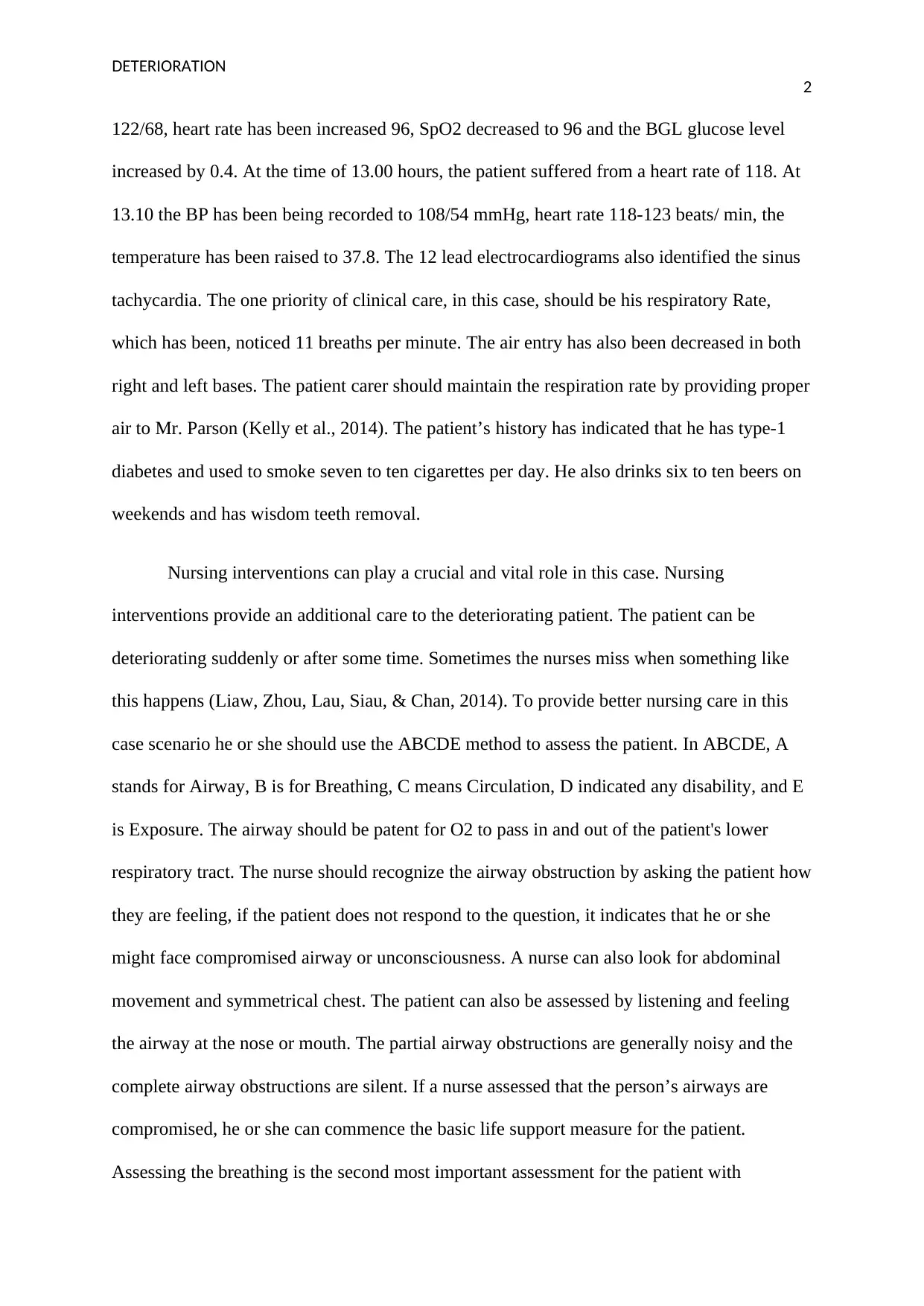
DETERIORATION
2
122/68, heart rate has been increased 96, SpO2 decreased to 96 and the BGL glucose level
increased by 0.4. At the time of 13.00 hours, the patient suffered from a heart rate of 118. At
13.10 the BP has been being recorded to 108/54 mmHg, heart rate 118-123 beats/ min, the
temperature has been raised to 37.8. The 12 lead electrocardiograms also identified the sinus
tachycardia. The one priority of clinical care, in this case, should be his respiratory Rate,
which has been, noticed 11 breaths per minute. The air entry has also been decreased in both
right and left bases. The patient carer should maintain the respiration rate by providing proper
air to Mr. Parson (Kelly et al., 2014). The patient’s history has indicated that he has type-1
diabetes and used to smoke seven to ten cigarettes per day. He also drinks six to ten beers on
weekends and has wisdom teeth removal.
Nursing interventions can play a crucial and vital role in this case. Nursing
interventions provide an additional care to the deteriorating patient. The patient can be
deteriorating suddenly or after some time. Sometimes the nurses miss when something like
this happens (Liaw, Zhou, Lau, Siau, & Chan, 2014). To provide better nursing care in this
case scenario he or she should use the ABCDE method to assess the patient. In ABCDE, A
stands for Airway, B is for Breathing, C means Circulation, D indicated any disability, and E
is Exposure. The airway should be patent for O2 to pass in and out of the patient's lower
respiratory tract. The nurse should recognize the airway obstruction by asking the patient how
they are feeling, if the patient does not respond to the question, it indicates that he or she
might face compromised airway or unconsciousness. A nurse can also look for abdominal
movement and symmetrical chest. The patient can also be assessed by listening and feeling
the airway at the nose or mouth. The partial airway obstructions are generally noisy and the
complete airway obstructions are silent. If a nurse assessed that the person’s airways are
compromised, he or she can commence the basic life support measure for the patient.
Assessing the breathing is the second most important assessment for the patient with
2
122/68, heart rate has been increased 96, SpO2 decreased to 96 and the BGL glucose level
increased by 0.4. At the time of 13.00 hours, the patient suffered from a heart rate of 118. At
13.10 the BP has been being recorded to 108/54 mmHg, heart rate 118-123 beats/ min, the
temperature has been raised to 37.8. The 12 lead electrocardiograms also identified the sinus
tachycardia. The one priority of clinical care, in this case, should be his respiratory Rate,
which has been, noticed 11 breaths per minute. The air entry has also been decreased in both
right and left bases. The patient carer should maintain the respiration rate by providing proper
air to Mr. Parson (Kelly et al., 2014). The patient’s history has indicated that he has type-1
diabetes and used to smoke seven to ten cigarettes per day. He also drinks six to ten beers on
weekends and has wisdom teeth removal.
Nursing interventions can play a crucial and vital role in this case. Nursing
interventions provide an additional care to the deteriorating patient. The patient can be
deteriorating suddenly or after some time. Sometimes the nurses miss when something like
this happens (Liaw, Zhou, Lau, Siau, & Chan, 2014). To provide better nursing care in this
case scenario he or she should use the ABCDE method to assess the patient. In ABCDE, A
stands for Airway, B is for Breathing, C means Circulation, D indicated any disability, and E
is Exposure. The airway should be patent for O2 to pass in and out of the patient's lower
respiratory tract. The nurse should recognize the airway obstruction by asking the patient how
they are feeling, if the patient does not respond to the question, it indicates that he or she
might face compromised airway or unconsciousness. A nurse can also look for abdominal
movement and symmetrical chest. The patient can also be assessed by listening and feeling
the airway at the nose or mouth. The partial airway obstructions are generally noisy and the
complete airway obstructions are silent. If a nurse assessed that the person’s airways are
compromised, he or she can commence the basic life support measure for the patient.
Assessing the breathing is the second most important assessment for the patient with
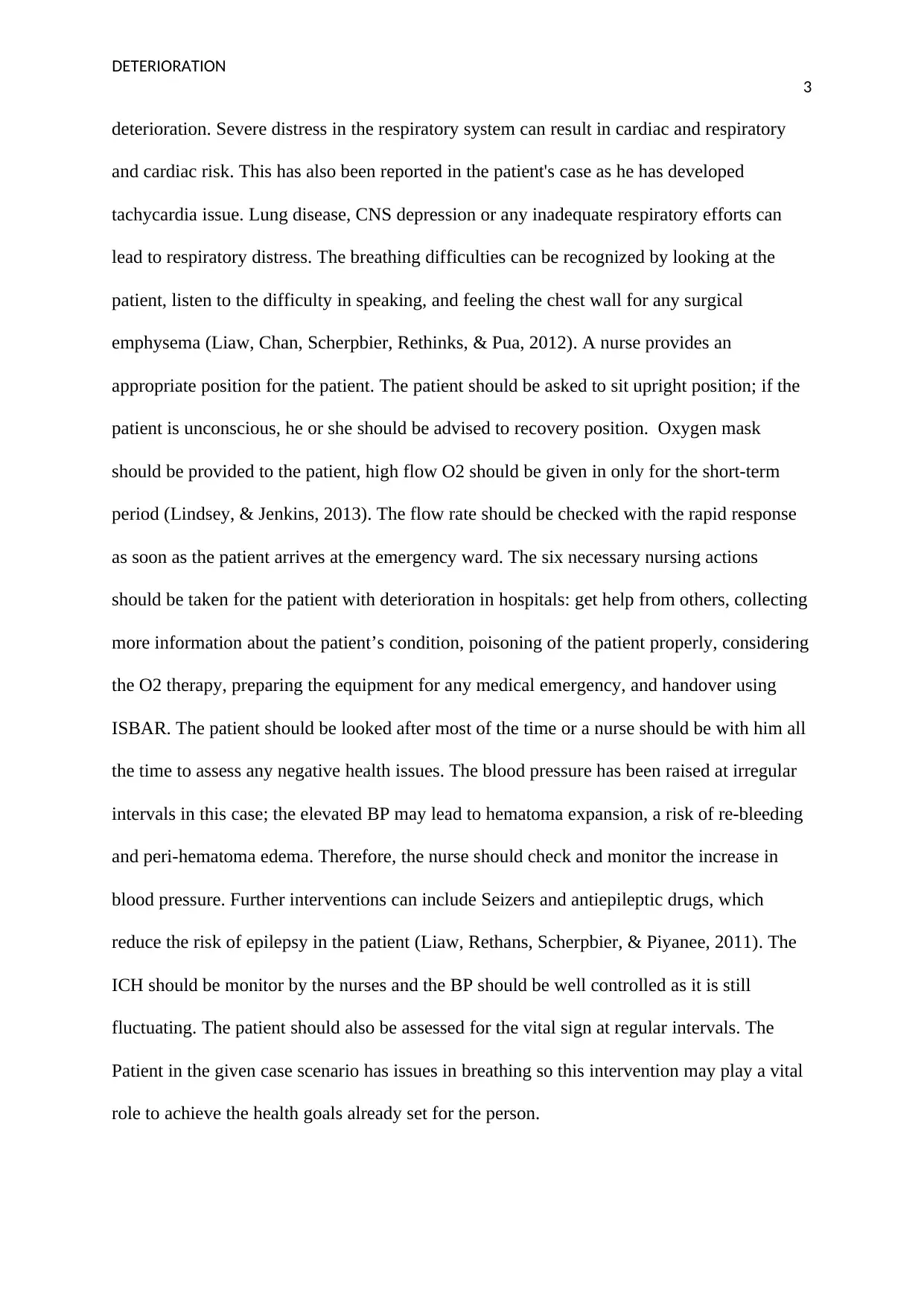
DETERIORATION
3
deterioration. Severe distress in the respiratory system can result in cardiac and respiratory
and cardiac risk. This has also been reported in the patient's case as he has developed
tachycardia issue. Lung disease, CNS depression or any inadequate respiratory efforts can
lead to respiratory distress. The breathing difficulties can be recognized by looking at the
patient, listen to the difficulty in speaking, and feeling the chest wall for any surgical
emphysema (Liaw, Chan, Scherpbier, Rethinks, & Pua, 2012). A nurse provides an
appropriate position for the patient. The patient should be asked to sit upright position; if the
patient is unconscious, he or she should be advised to recovery position. Oxygen mask
should be provided to the patient, high flow O2 should be given in only for the short-term
period (Lindsey, & Jenkins, 2013). The flow rate should be checked with the rapid response
as soon as the patient arrives at the emergency ward. The six necessary nursing actions
should be taken for the patient with deterioration in hospitals: get help from others, collecting
more information about the patient’s condition, poisoning of the patient properly, considering
the O2 therapy, preparing the equipment for any medical emergency, and handover using
ISBAR. The patient should be looked after most of the time or a nurse should be with him all
the time to assess any negative health issues. The blood pressure has been raised at irregular
intervals in this case; the elevated BP may lead to hematoma expansion, a risk of re-bleeding
and peri-hematoma edema. Therefore, the nurse should check and monitor the increase in
blood pressure. Further interventions can include Seizers and antiepileptic drugs, which
reduce the risk of epilepsy in the patient (Liaw, Rethans, Scherpbier, & Piyanee, 2011). The
ICH should be monitor by the nurses and the BP should be well controlled as it is still
fluctuating. The patient should also be assessed for the vital sign at regular intervals. The
Patient in the given case scenario has issues in breathing so this intervention may play a vital
role to achieve the health goals already set for the person.
3
deterioration. Severe distress in the respiratory system can result in cardiac and respiratory
and cardiac risk. This has also been reported in the patient's case as he has developed
tachycardia issue. Lung disease, CNS depression or any inadequate respiratory efforts can
lead to respiratory distress. The breathing difficulties can be recognized by looking at the
patient, listen to the difficulty in speaking, and feeling the chest wall for any surgical
emphysema (Liaw, Chan, Scherpbier, Rethinks, & Pua, 2012). A nurse provides an
appropriate position for the patient. The patient should be asked to sit upright position; if the
patient is unconscious, he or she should be advised to recovery position. Oxygen mask
should be provided to the patient, high flow O2 should be given in only for the short-term
period (Lindsey, & Jenkins, 2013). The flow rate should be checked with the rapid response
as soon as the patient arrives at the emergency ward. The six necessary nursing actions
should be taken for the patient with deterioration in hospitals: get help from others, collecting
more information about the patient’s condition, poisoning of the patient properly, considering
the O2 therapy, preparing the equipment for any medical emergency, and handover using
ISBAR. The patient should be looked after most of the time or a nurse should be with him all
the time to assess any negative health issues. The blood pressure has been raised at irregular
intervals in this case; the elevated BP may lead to hematoma expansion, a risk of re-bleeding
and peri-hematoma edema. Therefore, the nurse should check and monitor the increase in
blood pressure. Further interventions can include Seizers and antiepileptic drugs, which
reduce the risk of epilepsy in the patient (Liaw, Rethans, Scherpbier, & Piyanee, 2011). The
ICH should be monitor by the nurses and the BP should be well controlled as it is still
fluctuating. The patient should also be assessed for the vital sign at regular intervals. The
Patient in the given case scenario has issues in breathing so this intervention may play a vital
role to achieve the health goals already set for the person.
Secure Best Marks with AI Grader
Need help grading? Try our AI Grader for instant feedback on your assignments.
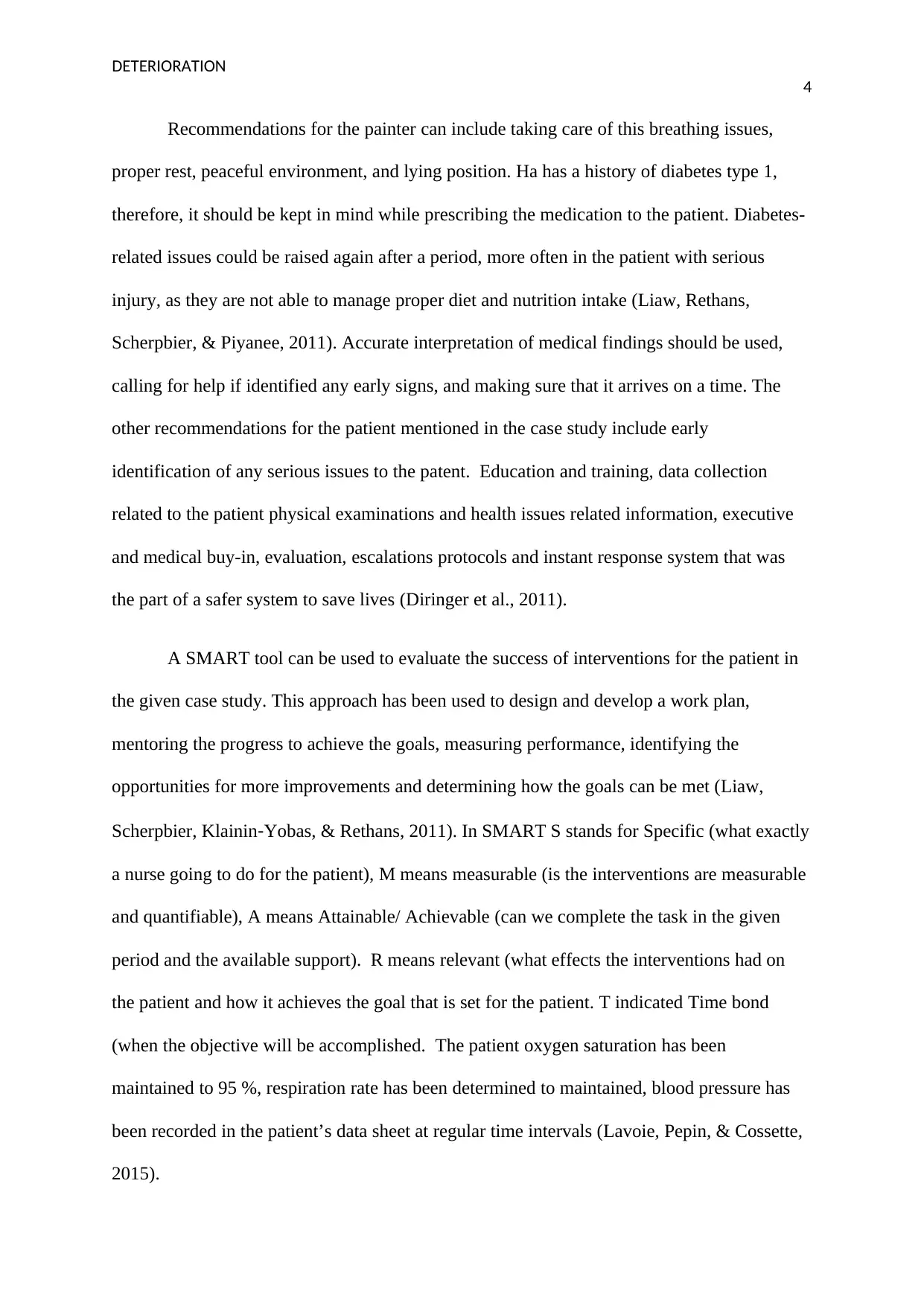
DETERIORATION
4
Recommendations for the painter can include taking care of this breathing issues,
proper rest, peaceful environment, and lying position. Ha has a history of diabetes type 1,
therefore, it should be kept in mind while prescribing the medication to the patient. Diabetes-
related issues could be raised again after a period, more often in the patient with serious
injury, as they are not able to manage proper diet and nutrition intake (Liaw, Rethans,
Scherpbier, & Piyanee, 2011). Accurate interpretation of medical findings should be used,
calling for help if identified any early signs, and making sure that it arrives on a time. The
other recommendations for the patient mentioned in the case study include early
identification of any serious issues to the patent. Education and training, data collection
related to the patient physical examinations and health issues related information, executive
and medical buy-in, evaluation, escalations protocols and instant response system that was
the part of a safer system to save lives (Diringer et al., 2011).
A SMART tool can be used to evaluate the success of interventions for the patient in
the given case study. This approach has been used to design and develop a work plan,
mentoring the progress to achieve the goals, measuring performance, identifying the
opportunities for more improvements and determining how the goals can be met (Liaw,
Scherpbier, Klainin‐Yobas, & Rethans, 2011). In SMART S stands for Specific (what exactly
a nurse going to do for the patient), M means measurable (is the interventions are measurable
and quantifiable), A means Attainable/ Achievable (can we complete the task in the given
period and the available support). R means relevant (what effects the interventions had on
the patient and how it achieves the goal that is set for the patient. T indicated Time bond
(when the objective will be accomplished. The patient oxygen saturation has been
maintained to 95 %, respiration rate has been determined to maintained, blood pressure has
been recorded in the patient’s data sheet at regular time intervals (Lavoie, Pepin, & Cossette,
2015).
4
Recommendations for the painter can include taking care of this breathing issues,
proper rest, peaceful environment, and lying position. Ha has a history of diabetes type 1,
therefore, it should be kept in mind while prescribing the medication to the patient. Diabetes-
related issues could be raised again after a period, more often in the patient with serious
injury, as they are not able to manage proper diet and nutrition intake (Liaw, Rethans,
Scherpbier, & Piyanee, 2011). Accurate interpretation of medical findings should be used,
calling for help if identified any early signs, and making sure that it arrives on a time. The
other recommendations for the patient mentioned in the case study include early
identification of any serious issues to the patent. Education and training, data collection
related to the patient physical examinations and health issues related information, executive
and medical buy-in, evaluation, escalations protocols and instant response system that was
the part of a safer system to save lives (Diringer et al., 2011).
A SMART tool can be used to evaluate the success of interventions for the patient in
the given case study. This approach has been used to design and develop a work plan,
mentoring the progress to achieve the goals, measuring performance, identifying the
opportunities for more improvements and determining how the goals can be met (Liaw,
Scherpbier, Klainin‐Yobas, & Rethans, 2011). In SMART S stands for Specific (what exactly
a nurse going to do for the patient), M means measurable (is the interventions are measurable
and quantifiable), A means Attainable/ Achievable (can we complete the task in the given
period and the available support). R means relevant (what effects the interventions had on
the patient and how it achieves the goal that is set for the patient. T indicated Time bond
(when the objective will be accomplished. The patient oxygen saturation has been
maintained to 95 %, respiration rate has been determined to maintained, blood pressure has
been recorded in the patient’s data sheet at regular time intervals (Lavoie, Pepin, & Cossette,
2015).
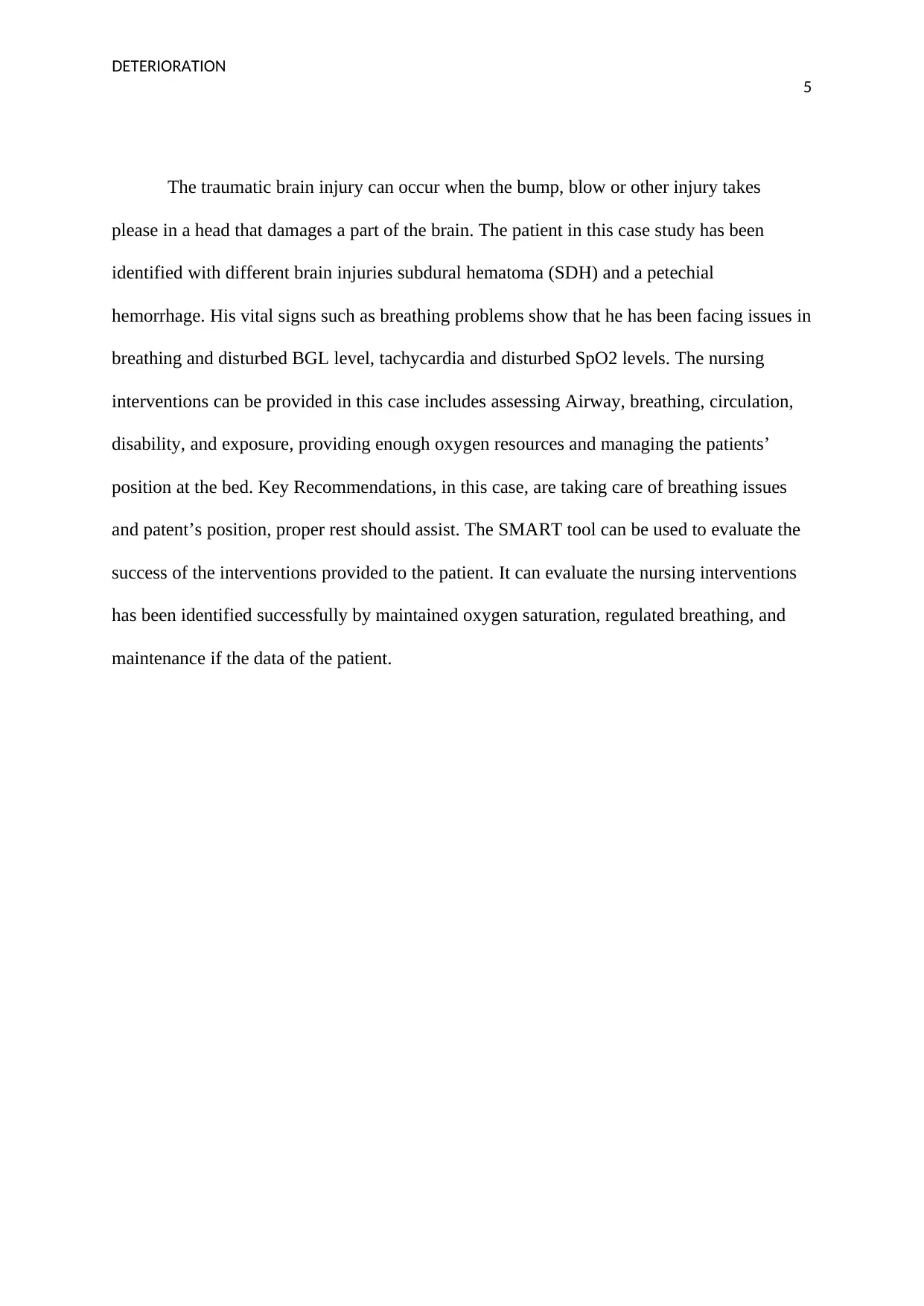
DETERIORATION
5
The traumatic brain injury can occur when the bump, blow or other injury takes
please in a head that damages a part of the brain. The patient in this case study has been
identified with different brain injuries subdural hematoma (SDH) and a petechial
hemorrhage. His vital signs such as breathing problems show that he has been facing issues in
breathing and disturbed BGL level, tachycardia and disturbed SpO2 levels. The nursing
interventions can be provided in this case includes assessing Airway, breathing, circulation,
disability, and exposure, providing enough oxygen resources and managing the patients’
position at the bed. Key Recommendations, in this case, are taking care of breathing issues
and patent’s position, proper rest should assist. The SMART tool can be used to evaluate the
success of the interventions provided to the patient. It can evaluate the nursing interventions
has been identified successfully by maintained oxygen saturation, regulated breathing, and
maintenance if the data of the patient.
5
The traumatic brain injury can occur when the bump, blow or other injury takes
please in a head that damages a part of the brain. The patient in this case study has been
identified with different brain injuries subdural hematoma (SDH) and a petechial
hemorrhage. His vital signs such as breathing problems show that he has been facing issues in
breathing and disturbed BGL level, tachycardia and disturbed SpO2 levels. The nursing
interventions can be provided in this case includes assessing Airway, breathing, circulation,
disability, and exposure, providing enough oxygen resources and managing the patients’
position at the bed. Key Recommendations, in this case, are taking care of breathing issues
and patent’s position, proper rest should assist. The SMART tool can be used to evaluate the
success of the interventions provided to the patient. It can evaluate the nursing interventions
has been identified successfully by maintained oxygen saturation, regulated breathing, and
maintenance if the data of the patient.
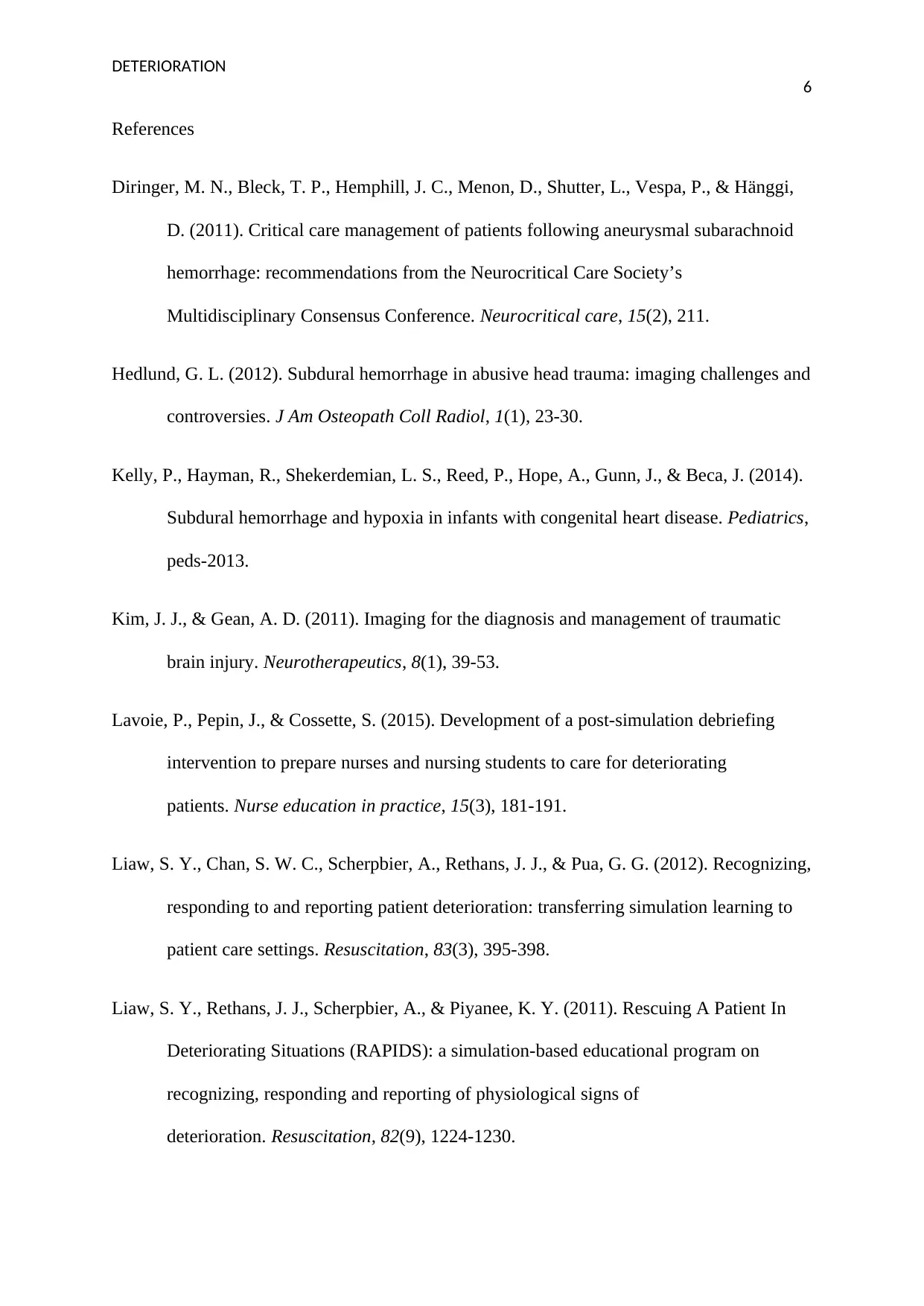
DETERIORATION
6
References
Diringer, M. N., Bleck, T. P., Hemphill, J. C., Menon, D., Shutter, L., Vespa, P., & Hänggi,
D. (2011). Critical care management of patients following aneurysmal subarachnoid
hemorrhage: recommendations from the Neurocritical Care Society’s
Multidisciplinary Consensus Conference. Neurocritical care, 15(2), 211.
Hedlund, G. L. (2012). Subdural hemorrhage in abusive head trauma: imaging challenges and
controversies. J Am Osteopath Coll Radiol, 1(1), 23-30.
Kelly, P., Hayman, R., Shekerdemian, L. S., Reed, P., Hope, A., Gunn, J., & Beca, J. (2014).
Subdural hemorrhage and hypoxia in infants with congenital heart disease. Pediatrics,
peds-2013.
Kim, J. J., & Gean, A. D. (2011). Imaging for the diagnosis and management of traumatic
brain injury. Neurotherapeutics, 8(1), 39-53.
Lavoie, P., Pepin, J., & Cossette, S. (2015). Development of a post-simulation debriefing
intervention to prepare nurses and nursing students to care for deteriorating
patients. Nurse education in practice, 15(3), 181-191.
Liaw, S. Y., Chan, S. W. C., Scherpbier, A., Rethans, J. J., & Pua, G. G. (2012). Recognizing,
responding to and reporting patient deterioration: transferring simulation learning to
patient care settings. Resuscitation, 83(3), 395-398.
Liaw, S. Y., Rethans, J. J., Scherpbier, A., & Piyanee, K. Y. (2011). Rescuing A Patient In
Deteriorating Situations (RAPIDS): a simulation-based educational program on
recognizing, responding and reporting of physiological signs of
deterioration. Resuscitation, 82(9), 1224-1230.
6
References
Diringer, M. N., Bleck, T. P., Hemphill, J. C., Menon, D., Shutter, L., Vespa, P., & Hänggi,
D. (2011). Critical care management of patients following aneurysmal subarachnoid
hemorrhage: recommendations from the Neurocritical Care Society’s
Multidisciplinary Consensus Conference. Neurocritical care, 15(2), 211.
Hedlund, G. L. (2012). Subdural hemorrhage in abusive head trauma: imaging challenges and
controversies. J Am Osteopath Coll Radiol, 1(1), 23-30.
Kelly, P., Hayman, R., Shekerdemian, L. S., Reed, P., Hope, A., Gunn, J., & Beca, J. (2014).
Subdural hemorrhage and hypoxia in infants with congenital heart disease. Pediatrics,
peds-2013.
Kim, J. J., & Gean, A. D. (2011). Imaging for the diagnosis and management of traumatic
brain injury. Neurotherapeutics, 8(1), 39-53.
Lavoie, P., Pepin, J., & Cossette, S. (2015). Development of a post-simulation debriefing
intervention to prepare nurses and nursing students to care for deteriorating
patients. Nurse education in practice, 15(3), 181-191.
Liaw, S. Y., Chan, S. W. C., Scherpbier, A., Rethans, J. J., & Pua, G. G. (2012). Recognizing,
responding to and reporting patient deterioration: transferring simulation learning to
patient care settings. Resuscitation, 83(3), 395-398.
Liaw, S. Y., Rethans, J. J., Scherpbier, A., & Piyanee, K. Y. (2011). Rescuing A Patient In
Deteriorating Situations (RAPIDS): a simulation-based educational program on
recognizing, responding and reporting of physiological signs of
deterioration. Resuscitation, 82(9), 1224-1230.
Paraphrase This Document
Need a fresh take? Get an instant paraphrase of this document with our AI Paraphraser
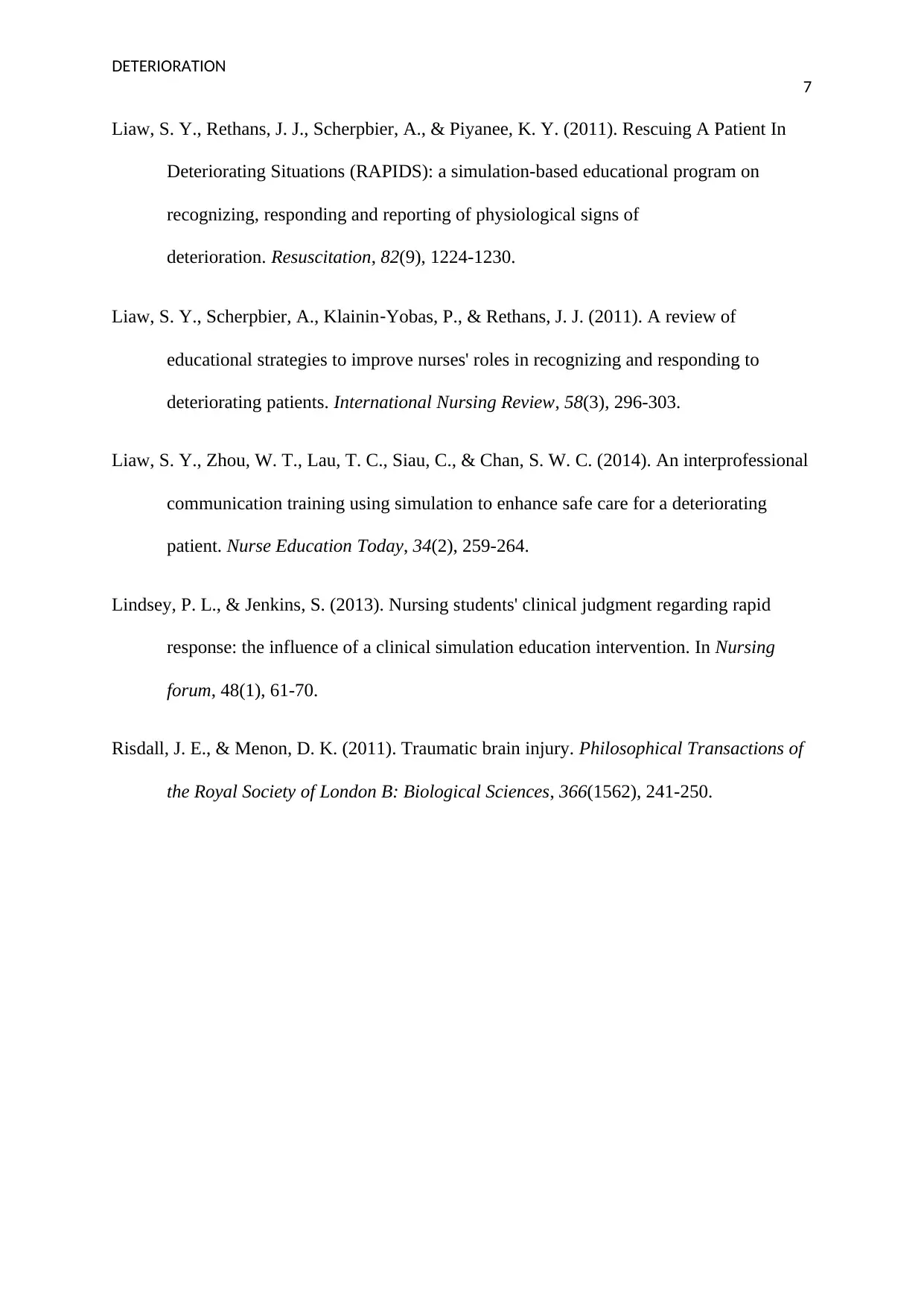
DETERIORATION
7
Liaw, S. Y., Rethans, J. J., Scherpbier, A., & Piyanee, K. Y. (2011). Rescuing A Patient In
Deteriorating Situations (RAPIDS): a simulation-based educational program on
recognizing, responding and reporting of physiological signs of
deterioration. Resuscitation, 82(9), 1224-1230.
Liaw, S. Y., Scherpbier, A., Klainin‐Yobas, P., & Rethans, J. J. (2011). A review of
educational strategies to improve nurses' roles in recognizing and responding to
deteriorating patients. International Nursing Review, 58(3), 296-303.
Liaw, S. Y., Zhou, W. T., Lau, T. C., Siau, C., & Chan, S. W. C. (2014). An interprofessional
communication training using simulation to enhance safe care for a deteriorating
patient. Nurse Education Today, 34(2), 259-264.
Lindsey, P. L., & Jenkins, S. (2013). Nursing students' clinical judgment regarding rapid
response: the influence of a clinical simulation education intervention. In Nursing
forum, 48(1), 61-70.
Risdall, J. E., & Menon, D. K. (2011). Traumatic brain injury. Philosophical Transactions of
the Royal Society of London B: Biological Sciences, 366(1562), 241-250.
7
Liaw, S. Y., Rethans, J. J., Scherpbier, A., & Piyanee, K. Y. (2011). Rescuing A Patient In
Deteriorating Situations (RAPIDS): a simulation-based educational program on
recognizing, responding and reporting of physiological signs of
deterioration. Resuscitation, 82(9), 1224-1230.
Liaw, S. Y., Scherpbier, A., Klainin‐Yobas, P., & Rethans, J. J. (2011). A review of
educational strategies to improve nurses' roles in recognizing and responding to
deteriorating patients. International Nursing Review, 58(3), 296-303.
Liaw, S. Y., Zhou, W. T., Lau, T. C., Siau, C., & Chan, S. W. C. (2014). An interprofessional
communication training using simulation to enhance safe care for a deteriorating
patient. Nurse Education Today, 34(2), 259-264.
Lindsey, P. L., & Jenkins, S. (2013). Nursing students' clinical judgment regarding rapid
response: the influence of a clinical simulation education intervention. In Nursing
forum, 48(1), 61-70.
Risdall, J. E., & Menon, D. K. (2011). Traumatic brain injury. Philosophical Transactions of
the Royal Society of London B: Biological Sciences, 366(1562), 241-250.
1 out of 8
Your All-in-One AI-Powered Toolkit for Academic Success.
+13062052269
info@desklib.com
Available 24*7 on WhatsApp / Email
![[object Object]](/_next/static/media/star-bottom.7253800d.svg)
Unlock your academic potential
© 2024 | Zucol Services PVT LTD | All rights reserved.

